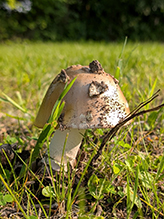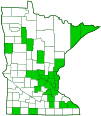Stubble Rosegill
(Volvopluteus gloiocephalus)
Conservation • Description • Habitat • Ecology • Distribution • Taxonomy
|
|
||||||||||||||
Description |
Stubble Rosegill is a common, large, gilled mushroom. It is most common in Europe and North America. It has been recorded on every continent except Antarctica. Molecular data has confirmed its presence in Europe and in California but reports outside of Europe and North America are unconfirmed. It occurs in the United States and southern Canada east of the Great Plains and on the West Coast, and there are scattered records in between. Stubble Rosegill is found in forests and woodlands and at their edges, in grassy fields, gardens, lawns, compost piles, and wood chips. It gets its nutrients from decaying organic matter (saprobic). When it first appears, the cap is convex and sticky. As it ages it expands, becoming broadly convex or broadly bell-shaped. Mature caps are 2″ to 6″ (5 to 15 cm) in diameter and almost flat, often with a raised bump (umbo) in the middle. The surface is smooth, shiny when dry, and sticky when wet. Occasionally there are patches, remnants of the universal veil, attached. The color is variable, pure white, gray, or grayish brown. Both dark and light caps have been produced from the same mycelium. The center is often darker. The margins are sometimes finely grooved (lined). The gills are not attached to the stalk (free). They are closely spaced or almost crowded, and there are frequent short gills between the main gills. They are white when young, becoming rose-colored or pink at maturity. This is the feature that gives the species the second part of its common name. The stalk is dry, 2″ to 8″ (5 to 20 cm) long, and ⅜″ to 1″ (10 to 25 mm) thick. It may be hairless (bald) or covered with fine, silky hairs. It is white at first, turning brownish with age. There is no ring on the stalk. The universal veil persists as a deep, white, sac-like cup (volva) at the base of the stalk. The volva is easily removed from the stalk, so that when the mushroom is picked, the volva usually remains in the soil. The flesh is white. It does not change color when sliced. It is edible but should be avoided due to its similarity in appearance with poisonous Amanita mushrooms. The spore print is brownish pink. |
Similar Species |
Habitat and Hosts |
|
Ecology |
Season |
|
Distribution |
||
|
Sources Biodiversity occurrence data published by: Minnesota Biodiversity Atlas (accessed through the Minnesota Biodiversity Atlas Portal, bellatlas.umn.edu, 6/28/2025). |
|
| 6/28/2025 | ||
Occurrence |
||
|
||
Taxonomy |
|
Kingdom |
Fungi (Fungi) |
Subkingdom |
Dikarya |
Phylum |
Basidiomycota (Basidiomycete Fungi) |
Subphylum |
Agaricomycotina (Higher Basidiomycetes) |
Class |
Agaricomycetes (Mushrooms, Bracket Fungi, Puffballs, and Allies) |
Subclass |
Agaricomycetidae |
Order |
|
Suborder |
Pluteineae |
Family |
Pluteaceae |
Genus |
Volvopluteus |
|
|
Until recently, this species was described as Agaricus gloiocephalus in 1815. It was moved to the genus Volvaria in 1878. In1953 it was moved to the genus Volvariella, and it was treated as Volvariella speciosa var. gloiocephala. In 1986 it was raised to species status and became Volvariella gloiocephala. In 2011, Volvariella gloiocephala and its allies were moved to a new genus Volvopluteus, and Volvopluteus gloiocephalus became the type species. Older printed field guides refer to this species as Volvaria speciosa or Volvariella speciosa. |
|
Subordinate Taxa |
|
|
|
Synonyms |
|
Agaricus gloiocephalus Agaricus pubescens Agaricus speciosus Amanita incarnata var. laevis Amanita speciosa Pluteus speciosus Volvaria gloiocephala Volvaria gloiocephala var. abyssinica Volvaria gloiocephala var. speciosa Volvaria pubescens Volvaria speciosa Volvaria speciosa ssp. gloiocephala Volvaria speciosa var. gloiocephala Volvariella gloiocephala Volvariella gloiocephala Volvariella gloiocephala ssp. speciosa Volvariella gloiocephala var. speciosa Volvariella speciosa Volvariella speciosa ssp. gloiocephala Volvariella speciosa var. gloiocephala Volvariopsis gloiocephala Volvariopsis speciosa |
|
Common Names |
|
Big-sheath Mushroom Rose-gilled Grisette Stubble Rosegill |
|
Glossary
Mycelium
The vegetative part of a fungus; consisting of a mass of branching, thread-like hyphae, through which a fungus absorbs nutrients from its environment; and excluding the fruiting, reproductive structure.
Saprobic
A term often used for saprotrophic fungi. Referring to fungi that obtain their nutrients from decayed organic matter.
Umbo
A blunt or round protuberance on the end of the scale of some pine cones. It is the first year’s growth of a two year old scale.
Universal veil
An egg-like structure that envelopes all or most of a developing gill mushroom. Remnants of the universal veil sometimes visible on a mature mushroom are patchy warts on the cap, a ring on the stem, and a volva at the base of the stem.
Volva
Also called cup. A cup-like covering at the base of a mushroom stem, sometimes buried. In Amanita, Volvariella, and some other mushrooms, it is the remnants of the universal veil ruptured by the mushroom pushing through. In Phallales it is the remnants of the ruptured peridium.
Visitor Photos |
||
Share your photo of this fungus. |
||
This button not working for you? |
||
Stephen Vander Wal |
||
 |
 |
|
| … My wife and I were just shocked at the size and color of it. | Of course, my wife and kids knocked it over to investigate it more. This is what it looked like on the underside. I told them to stop poking at the (unknown if deadly) mushroom until I could find something about it. Nobody died last night so I think we're in the clear. |
|
MinnesotaSeasons.com Photos |
||
|
||
|
||

Slideshows |
|

Visitor Videos |
||
Share your video of this fungus. |
||
This button not working for you? |
||
|
Other Videos |
||
Volvopluteus gloiocephalus, the big sheath mushroom, rose-gilled grisette, or stubble rosegill |
About
May 8, 2019 I go through the forests, mountains, hills, fields, and waters to understand the living world and to create a living mind. Volvopluteus gloiocephalus, the big sheath mushroom, rose-gilled grisette, or stubble rosegill |

Visitor Sightings |
||
Report a sighting of this fungus. |
||
This button not working for you? |
||
MinnesotaSeasons.com Sightings |
||
|

|
Created: 6/28/2025 Last Updated: © MinnesotaSeasons.com. All rights reserved. |

